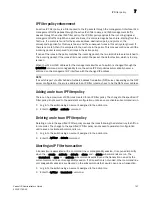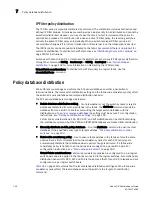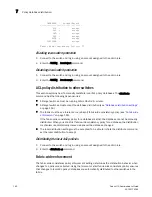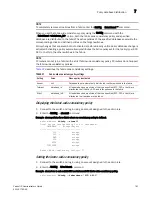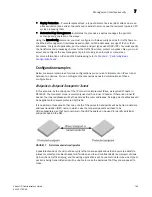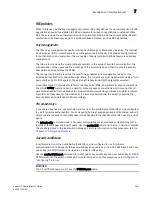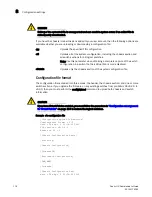
166
Fabric OS Administrator’s Guide
53-1001763-02
Management interface security
7
Gateway-to-Gateway Tunnel
In this scenario, neither endpoint of the IP connection implements IPsec, but the network nodes
between them protect traffic for part of the way. Protection is transparent to the endpoints, and
depends on ordinary routing to send packets through the tunnel endpoints for processing. Each
endpoint would announce the set of addresses behind it, and packets would be sent in tunnel
mode where the inner IP header would contain the IP addresses of the actual endpoints.
FIGURE 18
Gateway tunnel configuration
Endpoint-to-Gateway Tunnel
In this scenario, a protected endpoint (typically a portable computer) connects back to its corporate
network through an IPsec-protected tunnel. It might use this tunnel only to access information on
the corporate network, or it might tunnel all of its traffic back through the corporate network in
order to take advantage of protection provided by a corporate firewall against Internet-based
attacks. In either case, the protected endpoint will want an IP address associated with the security
gateway so that packets returned to it will go to the security gateway and be tunneled back.
FIGURE 19
Endpoint to gateway tunnel configuration
RoadWarrior configuration
In endpoint-to-endpoint security, packets are encrypted and decrypted by the host which produces
or consumes the traffic. In the gateway-to-gateway example, a router on the network encrypts and
decrypts the packets on behalf of the hosts on a protected network. A combination of the two is
referred to as a RoadWarrior configuration where a host on the internet requires access to a
network through a security gateway that is protecting the network.
IPsec protocols
IPsec uses two different protocols, Authentication Header (AH) and Encapsulating Security Payload
(ESP), to ensure the authentication, integrity and confidentiality of the communication.
Содержание 53-1001763-02
Страница 1: ...53 1001763 02 13 September 2010 Fabric OS Administrator s Guide Supporting Fabric OS v6 4 0 ...
Страница 4: ...iv Fabric OS Administrator s Guide 53 1001763 02 ...
Страница 24: ...xxiv Fabric OS Administrator s Guide 53 1001763 02 ...
Страница 28: ...xxviii Fabric OS Administrator s Guide 53 1001763 02 ...
Страница 32: ...xxxii Fabric OS Administrator s Guide 53 1001763 02 ...
Страница 40: ...xl Fabric OS Administrator s Guide 53 1001763 02 ...
Страница 42: ...2 Fabric OS Administrator s Guide 53 1001763 02 ...
Страница 54: ...14 Fabric OS Administrator s Guide 53 1001763 02 High availability of daemon processes 1 ...
Страница 74: ...34 Fabric OS Administrator s Guide 53 1001763 02 Basic connections 2 ...
Страница 102: ...62 Fabric OS Administrator s Guide 53 1001763 02 Audit log configuration 3 ...
Страница 156: ...116 Fabric OS Administrator s Guide 53 1001763 02 The authentication model using RADIUS and LDAP 5 ...
Страница 214: ...174 Fabric OS Administrator s Guide 53 1001763 02 Management interface security 7 ...
Страница 228: ...188 Fabric OS Administrator s Guide 53 1001763 02 Brocade configuration form 8 ...
Страница 276: ...236 Fabric OS Administrator s Guide 53 1001763 02 Creating a logical fabric using XISLs 10 ...
Страница 404: ...364 Fabric OS Administrator s Guide 53 1001763 02 ...
Страница 440: ...400 Fabric OS Administrator s Guide 53 1001763 02 Performance data collection 17 ...
Страница 464: ...424 Fabric OS Administrator s Guide 53 1001763 02 Disabling bottleneck detection on a switch 18 ...
Страница 480: ...440 Fabric OS Administrator s Guide 53 1001763 02 F_Port masterless trunking 19 ...
Страница 494: ...454 Fabric OS Administrator s Guide 53 1001763 02 Buffer credit recovery 20 ...
Страница 560: ...520 Fabric OS Administrator s Guide 53 1001763 02 Port indexing on the Brocade DCX 4S backbone C ...
Страница 574: ...534 Fabric OS Administrator s Guide 53 1001763 02 Hexadecimal overview E ...






